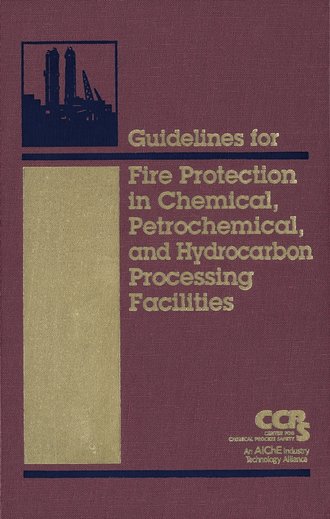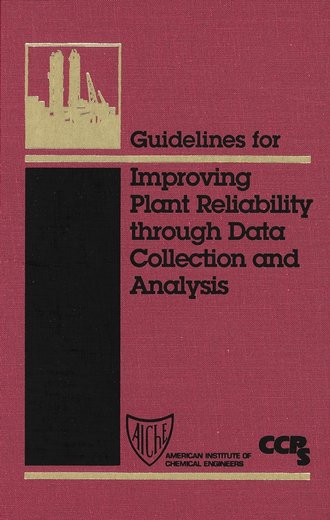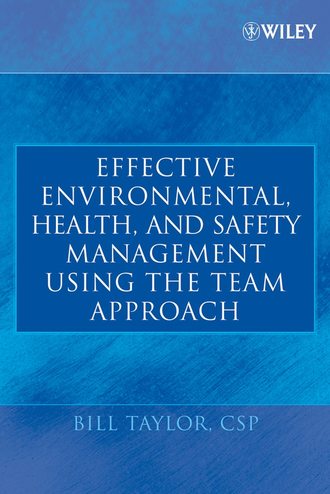техническая литература
Structural Reliability
Maurice Lemaire
This book describes the main methods used in the reliability of structures and their use in the design process leading to reliable products. This title provides the understanding needed to implement the variety of new reliability software programs.
Angewandte Baudynamik
Helmut Kramer
Obwohl Schwingungsprobleme in der Praxis zunehmend auftreten, werden sie von Tragwerkplanern gern umgangen. Statische Ersatzlasten, Sto?faktoren oder Schwingbeiwerte werden angewendet, ohne sich der Anwendungsgrenzen bewu?t zu sein. Dieses Buch...
Spectral Analysis
Francis Castani?
This book deals with these parametric methods, first discussing those based on time series models, Capon’s method and its variants, and then estimators based on the notions of sub-spaces. However, the book also deals with the traditional...
Guidelines for Fire Protection in Chemical, Petrochemical, and Hydrocarbon Processing Facilities
CCPS (Center for Chemical Process Safety)
While there are many resources available on fire protection and prevention in chemical petrochemical and petroleum plants—this is the first book that pulls them all together in one comprehensive resource. This book provides the tools to develop,...
Non-Binary Error Control Coding for Wireless Communication and Data Storage
Martin Johnston
Comprehensive introduction to non-binary error-correction coding techniques Non-Binary Error Control Coding for Wireless Communication and Data Storage explores non-binary coding schemes that have been developed to provide an alternative to the...
OFDM and MC-CDMA for Broadband Multi-User Communications, WLANs and Broadcasting
Thomas Keller
Orthogonal frequency-division multiplexing (OFDM) is a method of digital modulation in which a signal is split into several narrowband channels at different frequencies. CDMA is a form of multiplexing, which allows numerous signals to occupy a...
High Frequency Conducted Emission in AC Motor Drives Fed By Frequency Converters
Jaroslaw Luszcz
Provides a concise and thorough reference for designing electrical and electronic systems that employ adjustable speed drives Electrical and electronic systems that employ adjustable speed drives are being increasingly used in present-day...
Basic Research and Technologies for Two-Stage-to-Orbit Vehicles
Gottfried Sachs
Focusing on basic aspects of future reusable space transportation systems and covering overall design, aerodynamics, thermodynamics, flight dynamics, propulsion, materials, and structures, this report presents some of the most recent results...
Safe Design and Operation of Process Vents and Emission Control Systems
CCPS (Center for Chemical Process Safety)
Process vent header collection systems are subject to continually varying compositions and flow rates and thus present significant challenges for safe design. Due to increasingly demanding safety, health, environmental, and property protection...
Human Factors Methods for Improving Performance in the Process Industries
Daniel Crowl A.
Human Factors Methods for Improving Performance in the Process Industries provides guidance for managers and plant engineering staff on specific, practical techniques and tools for addressing forty different human factors issues impacting...
Guidelines for Improving Plant Reliability Through Data Collection and Analysis
CCPS (Center for Chemical Process Safety)
Written by reliability data experts, the book gives plant managers and supervisors the guidance they need to collect, and use with confidence, process equipment reliability data for risk-based decisions. Focusing on the process industries, it...
Wind Flow and Vapor Cloud Dispersion at Industrial and Urban Sites
Steven Hanna R.
A key component of risk reduction is reducing the potential consequences that could result from toxic or flammable releases. The science of vapor cloud dispersion has advanced significantly in recent years, but one of the long-standing...
Histological Analysis of Endocrine Disruptive Effects in Small Laboratory Fish
Daniel Dietrich
Timely title assembling the combined knowledge of some of the leading authorities in the field of small fish reproduction – an important topic for risk assessment and registration of chemical, agricultural, and pharmaceutical compounds Provides...
Effective Environmental, Health, and Safety Management Using the Team Approach
Bill Taylor
An important and highly actionable blueprint for optimum workplace safety Health and safety management is an ongoing concern in today's workplace. Effective Environmental, Health, and Safety Management Using the Team Approach provides today's...
Properties of Group-IV, III-V and II-VI Semiconductors
Sadao Adachi
Almost all the semiconductors of practical interest are the group-IV, III-V and II-VI semiconductors and the range of technical applications of such semiconductors is extremely wide. The purpose of this book is twofold: * to discuss the key...
Morphotropic Phase Boundary Perovskites, High Strain Piezoelectrics, and Dielectric Ceramics
Carl Wu
Proceedings of the Symposium on Dielectric Materials and Multilayer Electronic Devices and the Symposium on Morphotropic Phase Boundary Phenomena and Perovskite Materials, held April 28 – May 1, 2002, in St. Louis, Missouri, during the 104th...
Characterization and Control of Interfaces for High Quality Advanced Materials
Kiyoshi Nogi
Interface characterization and control are critical in the design and manufacture of high quality advanced materials, particularly, for nanomaterials. This proceedings features papers on interface science and technology that provide a unique and...
Real-Time Stability Assessment in Modern Power System Control Centers
S. Savulescu C.
This book answers the need for a practical, hands-on guide for assessing power stability in real time, rather than in offline simulations. Since the book is primarily geared toward the practical aspects of the subject, theoretical background is...
Service Automation and Dynamic Provisioning Techniques in IP / MPLS Environments
Mohamed Boucadair
Save time & resources with this comprehensive guide to automation configuration for the value-added IP services of the future. As the Internet becomes the medium of choice for value-added IP service offerings such as TV broadcasting,...
Bandwidth-Efficient Digital Modulation with Application to Deep-Space Communications
Marvin Simon K.
An important look at bandwidth-efficient modulations with applications to today's Space program Based on research and results obtained at the California Institute of Technology's Jet Propulsion Laboratory, this timely book defines, describes,...
Metamaterials
Nader Engheta
Leading experts explore the exotic properties and exciting applications of electromagnetic metamaterials Metamaterials: Physics and Engineering Explorations gives readers a clearly written, richly illustrated introduction to the most recent...
RELEASE
John Woodward L.
This book documents CCPS's Aerosol Research Program to develop a model to predict liquid rainout from release of a pressurized, liquefied gas–and, hence the residual amount of material in a vapor cloud, which may be greater than the amount...
Adsorbents
Ralph Yang T.
Adsorption promises to play an integral role in several future energy and environmental technologies, including hydrogen storage, CO removal for fuel cell technology, desulfurization of transportation fuels, and technologies for meeting higher...
Adhesion
Wulff Possart
Emphasizing the most recent developments this book addresses both the basic and applied aspects of adhesion. The authors present the latest results on fundamental aspects, adhesion in biology, chemistry for adhesive formulation, surface...
Kunststoffe
Wilhelm Keim
Als Kunststoffe werden hochmolekulare Substanzen bezeichnet, aus denen sich mittels geeigneter Verarbeitungsprozesse Formkorper herstellen lassen, die bei Raumtemperatur hart und steif sind. Sie zahlen wie Fasern, Folien, Elastomere,...
Klebtechnik
Walter Brockmann
Um solide, langzeitbestandige und stoffgerechte Klebungen im industriellen oder handwerklichen Bereich herzustellen, sind sowohl gute Grundlagenkenntnisse als auch fachlich fundiertes Wissen von Noten. Die einzelnen Informationen in der...
Nanotechnology
Wolfgang Fritzsche
Expectations of a technological revolution are associated with nanotechnology, and indeed the generation, modification and utilization of objects with tiniest dimensions already permeates science and research in a way that the absence of...
Fluidverfahrenstechnik
Ralf Goedecke
Von Praktikern fur Praktiker geschrieben, erlautert das vorliegende Werk die prozesstechnische Behandlung von Flussigkeits- und Gasgemischen zur Reinigung, Auftrennung und Aufkonzentrierung der einzelnen Komponenten durch den Einsatz selektiver...
Poromechanics
Olivier Coussy
Modelling and predicting how porous media deform when subjected to external actions and physical phenomena, including the effect of saturating fluids, are of importance to the understanding of geophysics and civil engineering (including soil and...
Concrete
Susan MacDonald
This book deals with the diagnosis, prognosis and repair issues associated with concrete buildings. Since the patenting and subsequent large-scale manufacture of modern cement, in the nineteenth century, concrete has become one of the most...
Stahlbau
Rolf Kindmann
The central themes are structural stability, the determination of loading according to 2nd order theory and the verification of load-bearing capacity. The actual load-bearing behaviour is explained, suitable verification procedures are...
Stahlbau
Ulrich Kr?ger
Das Werk umfasst die Grundlagen aus DIN 18800 Teile 1 und 2, als Lehrstoff aufgearbeitet fur Studenten des Bauingenieurwesens der mittleren Semester gleicherma?en wie fur Stahlbau-Ingenieure in der Praxis. Das Buch stellt ein nutzliches Lern-...
Geotechnik
Gerd Moller
Das Buch vermittelt alle wichtigen Aspekte ?ber den Aufbau und die Eigenschaften des Bodens, die bei der Planung und Berechnung sowie bei der Begutachtung von Sch?den des Systems Bauwerk-Baugrund zu ber?cksichtigen sind. Schwerpunkte sind die...
Lawsuit!
Randall Goodden L.
Addressing product liability concerns and laws both in the U.S. and internationally, this book helps manufacturers and engineers develop and implement proactive processes that can reduce liability concerns and potential lawsuits. It discusses...
Wear
Gwidon Stachowiak W.
Tribology is emerging from the realm of steam engines and crank-case lubricants and becoming key to vital new technologies such as nanotechnology and MEMS. Wear is an integral part of tribology, and an effective understanding and appreciation of...
Prebiotics
Bob Rastall
The prebiotic concept works on the basis that many potentially health-promoting microorganisms are already present in humans. Prebiotics are non-digestible food ingredients that stimulate activity in targeted microorganisms, to improve the...
Nutraceuticals
Paul LaChance A.
Phytochemicals are components acting individually, additively or synergistically, usually as a component of whole food, that have the characteristics of providing protective, preventative and possibly curative roles in the pathogenesis of cancer...
Salmonella
Chris Bell
Human illness attributed to foodborne pathogenic microorganisms has been prominent in the mass media in recent years. The Practical Food Microbiology Series has been devised to give practical and accurate information about specific organisms of...
HACCP
Carol Wallace
The Hazard Analysis and Critical Control Point (HACCP) system is a preventative food safety management system, that can be applied throughout the food supply chain from primary production to the consumer. HACCP is internationally recognised as...
Wine
Jokie Bakker
The commercial importance of wine continues to increase across the globe, with the availability of many new wines, encompassing a remarkable and exciting range of flavours. Wine Flavour Chemistry focuses on aspects of wine making procedures that...
Lebensmittelverfahrenstechnik
Harald Schuchmann
Wer mochte nicht wissen, was in unseren Lebensmitteln steckt und wie sie zu traditionellen oder neuen Produkten weiterverarbeitet werden? Viele Nahrungsmittel mussen, um genie?bar zu sein oder den sensorischen Anspruchen von Konsumenten zu...
Colorimetry
Alan Robertson
Colorimetry, the science of quantitvely describing color, is essential for color reproduction technology. This is because it creates standards by which to measure color, using mathematical techniques and software to ensure fidelity across media,...
Tomography
Pierre Grangeat
The principle of tomography is to explore the structure and composition of objects non-destructively along spatial and temporal dimensions, using penetrating radiation, such as X- and gamma-rays, or waves, such as electromagnetic and acoustic...
Nanophotonics
Jean-Michel Lourtioz
Nanophotonicsis a comprehensive introduction to the emerging area concerned with controlling and shaping optical fields at a subwavelength scale. Photonic crystals and microcavities are extensively described, including non-linear optical...
Holography
Jurgen Eichler
From fundamentals to advanced experiments and applications, this book explains how holography works. It guides students from simple optics to advanced topics in holography, following a practical approach using real-world materials. This proven...
Nanoscale
Nigel Cameron
An authoritative examination of the present and potential impact of nanoscale science and technology on modern life Because truly transformative technologies have far-reaching consequences, they always generate controversy. Establishing an...
Electroceramics
J. Herbert M.
Electroceramics, Materials, Properties, Applications, Second Edition provides a comprehensive treatment of the many aspects of ceramics and their electrical applications. The fundamentals of how electroceramics function are carefully introduced...
Nanomaterials
Shakeel Ahmed
This timely volume on nanomaterials and their biomedical and environmental applications includes the fundamentals of nanoparticles, and state-of-the-art properties, characterization, and the synthesis methods as well as the applications. The...
Strangpressen
Horst Gers
Strangpressen ist eines der wichtigsten Fertigungsverfahren in der Metallindustrie. Der Tagungsband zeigt auf, wie das Strangpressen zu innovativen Probleml?sungen beitragen kann und welche Anforderungen dabei an den Strangpressbetreiber als...


















































